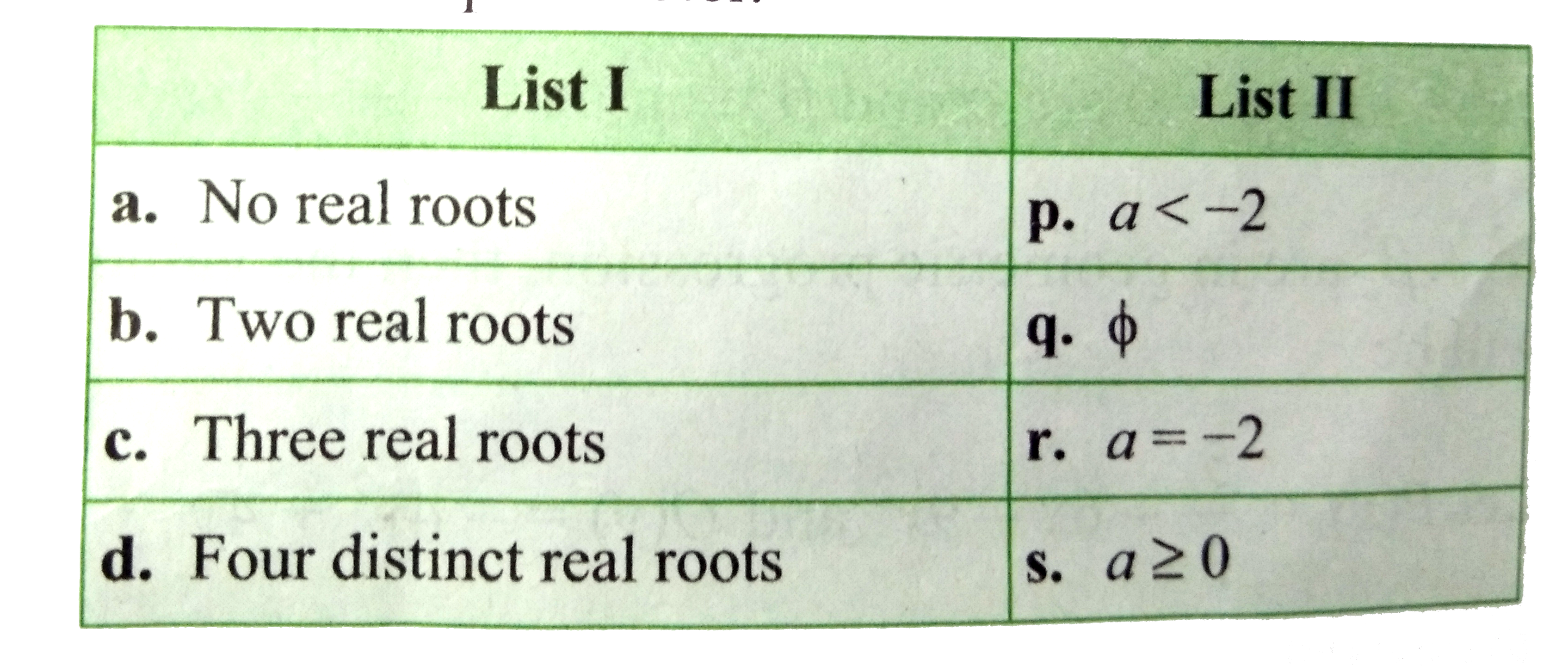the roots of the equation (a+√b)x2−15+(a−√b)x2−15=2a where a2−b=1 areSolution in Tamil
±4
±3
±√14
±√5
The correct Answer is:1,3
We have (a+√b)x2−15+1(a+√b)x2−15=2a
y2−2ay+1=0, where y=(a+√b)x2−15
∴y=a±√a2−1=a±√b=(a+√b)x2−15
So, x2−15=±1
∴x=±4,√14 .
Topper's Solved these Questions
- BOOK - CENGAGECHAPTER - THEORY OF EQUATIONSEXERCISE - Exercise (Comprehension)37videos
THEORY OF EQUATIONS
- BOOK - CENGAGECHAPTER - THEORY OF EQUATIONSEXERCISE - Exercise (Matrix)6videos
THEORY OF EQUATIONS
- BOOK - CENGAGECHAPTER - THEORY OF EQUATIONSEXERCISE - Exercise (Single)89videos
THEORY OF EQUATIONS
- BOOK - CENGAGECHAPTER - STRAIGHT LINESEXERCISE - JEE Advanced Previous Year4videos
STRAIGHT LINES
- BOOK - CENGAGECHAPTER - THREE DIMENSIONAL GEOMETRYEXERCISE - Question Bank12videos
THREE DIMENSIONAL GEOMETRY
Similar Questions
Consider an unknow polynomial which divided by (x−3) and (x−4) leaves remainder 2 and 1, respectively. Let R(x) be the remainder when this polynomial is divided by (x−3)(x−4).
If equations R(x)=x2+ax+1 has two distint real roots, then exhaustive values of a are.02:15View SolutionMatch the following for the equation x2+a|x|+1=0 where, a is a parameter.
 03:03View Solution
03:03View SolutionThe value of expression x4−8x3+18x2−8x+2 when x=2+√3
03:03View Solutionabout to only mathematics
03:03View SolutionThe equation of the plane which has the property that the point Q(5,4,5) is the reflection of point P(1,2,3) through that plane, is ax+by+cz=d where a,b,c,d∈N. Find the least value of (a+b+c+d).
05:03View SolutionIf ∫x+1x2+x+3dx=aln∣∣x2+x+3∣∣+1√btan−1(cx+d√11)+k, then the value of 2a+b+c+d is 15 b. 26 c.292 d. 13
05:47View Solutionf(x)=((1)/(sqrt(b-a)))(((sqrt((b-a)/(a)))sin2x)/(sqrt(1+(((sqrt(b-a))/(a)))sin x)))(sqrt(a+b tan^(2)x) at x=3(pi)/(4)(sqrt(a+b tan^(2)x)
04:31View Solutionf(x)=((1)/(sqrt(b-a)))(((sqrt((b-a)/(a)))sin2x)/(sqrt(1+(((sqrt(b-a))/(a)))sin x)))(sqrt(a+b tan^(2)x) at x=3(pi)/(4)(sqrt(a+b tan^(2)x)
02:46View Solutionf(x)=(1√b−a)⎛⎜ ⎜ ⎜ ⎜ ⎜⎝(√b−aa)sin2x√1+((√b−aa))sinx2⎞⎟ ⎟ ⎟ ⎟ ⎟⎠(√a+btan2x at x=3π4
04:28View SolutionThe no of real solutions of the equation (15+sqrt(14))^(t)+(15-sqrt(14))^(t)=30 are where t=x^(2)-2|x|
View SolutionIf x=3√a+√a2+b3+3√a−√a2+b3, then x3+3bx=
03:56View SolutionIf the product of the roots of the equation,x((3)/(4))(log_(2)x)^(2)+log_(2)x-(5)/(4)=sqrt(2) is (1)/((a)^((1)/(b))) (where a,b in N ) then the value of (a+b)
09:00View SolutionIf 2x=√ab−√ba, then show that 2a√1+x2x+√1+x2=a+b
04:57View SolutionIf ∞∑k=11(k+2)√k+k√k+2=√a+√b√c, where a,b,c∈N and a,b,c∈[1,15], then a + b + c is equal to
05:50View Solutionमाना (a+√b)Q(x)+(a−√b)Q(x)−2λ=A जहाँ λ,∈N,A,∈R तथा a2−b=1
∴(a+√b)(a−√b)=1⇒(a+√b)=(a−√b)−1 तथा (a−√b)=(a+√b)−1
अथार्त (a±√b)=(a+√b)±1or(a−√b)≠1
समीकरण में (a+√b)(2(x)) ko t में एक दिवघाट प्राप्त करेंगे |
तथा a+ar+ar2......∞=a1−r जहाँ −1<r<1
(2+√3)x2−2x+1+(2−√3)x2−2x−1=42−√3 का हल है-04:41View Solutionमाना (a+√b)Q(x)+(a−√b)Q(x)−2λ=A जहाँ λ,∈N,A,∈R तथा a2−b=1
∴(a+√b)(a−√b)=1⇒(a+√b)=(a−√b)−1 तथा (a−√b)=(a+√b)−1
अथार्त (a±√b)=(a+√b)±1or(a−√b)≠1
समीकरण में (a+√b)(2(x)) ko t में एक दिवघाट प्राप्त करेंगे |
तथा a+ar+ar2......∞=a1−r जहाँ −1<r<1
समीकरण (15+4√14)t+(15−4√14)t=30 जहाँ t=x2−2|x| के वास्तविक हलों की संख्या है-04:24View Solution

